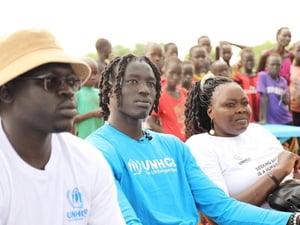Returns to northern Yemen cautious and slow
Returns to northern Yemen cautious and slow
More than two months after the cease-fire and a month after the officially declared end of the conflict in northern Yemen, an estimated 7,000 displaced Yemeni civilians from the camps at Al Mazraq have visited their home areas to assess destruction and damage to their farms and other property.
We estimate that only a quarter of those people who have made these visits have then decided to stay in their towns or villages. Most remain displaced amid continuing concerns about insecurity, ongoing skirmishes, landmines, lack of basic services and a lack of shelter as many homes were either destroyed or partially damaged. Many of these internally displaced persons (IDPs) tell UNHCR they are unsure that peace will last. They are also very worried about landmines and unexploded ordnance in their villages.
These fears are being reinforced by frequent reports of deadly landmine incidents. This month alone, at least two children lost their lives and another nine children and adults were seriously injured. In addition to the loss of lives, these incidents are adversely affecting the safety of returns and school attendance in areas which were affected by the conflict. Intensive awareness campaigns are underway in all areas hosting IDPs, including in the camps, to minimize civilian casualties.
Meanwhile, the three IDP camps at Al Mazraq continue to shelter over 27,000 displaced people. Most of the estimated 280,000 displaced people in Yemen are staying in host communities with friends, relatives or neighbours. The situation for some of those in Hajjah and Amran governorates is becoming untenable as their host families and the IDPs themselves are fast running out of resources.
Being without identification documents some IDPs are unable to register with the authorities in Hajjah governorate, which hinders their access to humanitarian assistance. Interviews with these people have confirmed their difficult situation. Urgent needs of their families force them to sell whatever they still have, including remaining cattle.
We fear that this group is becoming increasingly vulnerable and a potential target for abuse or exploitation. UNHCR is engaging the Yemeni authorities on this issue to ensure the registration of these people as IDPs and their access to humanitarian aid, which should improve their situation.
There is now a huge gap in meeting the needs of Yemeni IDPs as our operation in Yemen continues to face a serious funding shortfall. Between August and December 2009 we assisted 100,000 IDPs. So far this year we were able to assist some 50,000 displaced Yemenis. At present, we have funds to meet the needs of anther 30,000 IDPs by the end of June. Unless new funding is provided urgently, UNHCR will not be able to provide protection, shelter and humanitarian assistance to some 170,000 refugees and 280,000 IDPs in Yemen.
UNHCR's part of the 2010 UN consolidated appeal for Yemen amounts to US$ 39 million. To date, we have received 35 per cent of the needed funds.









